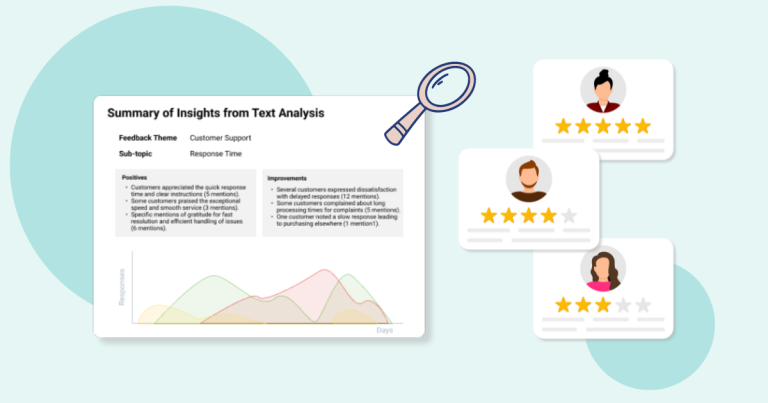A Voice of the Customer (VoC) program allows your company to gather, analyze, and respond to customer feedback across various channels to improve the customer experience. One of the most challenging aspects of setting up a VoC program is establishing which metrics to track. There are several VoC metrics you can track but, ultimately, you should set up those metrics that make the most sense for your company. The reason behind this is that VoC metrics help guide effective decision-making towards business success. It is, also, important to remember that just because somebody else is using a specific metric you shouldn’t feel compelled to use it as well.
How to Select the Right VoC Metrics
When developing a VoC program, it’s essential to pinpoint the specific business challenges your organization is currently struggling with. This crucial step will help direct your choices in metrics, ensuring they align with and support your broader business goals.
Before rolling out any metrics, consider how the different parts of the organization influence and are affected by the customer experience. Consider the main stakeholders and their priorities. Successful VoC initiatives hinge on this engagement, as the program must reflect and support their business objectives. This alignment is key to leveraging VoC insights to achieve meaningful business results and will also help define the most relevant VoC metrics for your organization.
Before you select specific VoC metrics, it’s important to connect them with existing key performance indicators (KPIs) and loyalty metrics. Begin by analyzing the existing data in your database to understand customer segments and their feedback historically. This preliminary analysis is vital as it sets the stage for what metrics will be most effective and should be monitored moving forward.
Customer feedback comes in three different forms. Along the customer journey you can capture direct, indirect, or inferred feedback. The goal is to collect data from more than one source and establish the most suitable metrics to track. Here is a list of the most well-established Voice of Customer metrics.
Net Promoter Score
The Net Promoter Score (NPS) assesses whether customers are likely to recommend your product or service to a family member, friend, or colleague. NPS is favored widely due to its simplicity and ease of calculation. Furthermore, it allows you to compare your company’s score with the industry average, providing a clear benchmark for your performance relative to your competitors.
Customer Effort Score
The Customer Effort Score (CES) is determined by how little effort a customer needs to expend to resolve an issue—the less effort required, the better the score. CES is particularly useful in call centers or customer support settings. One of the challenges with CES is that it operates on a scale different from other common metrics, which can make it challenging for internal stakeholders to understand and compare with other data.
Customer Satisfaction
Although the overall Customer Satisfaction Score (CSAT) may not be the most reliable predictor of future financial outcomes, it remains a prevalent metric in transactional surveys. The primary aim of CSAT is to gauge customer sentiments regarding specific aspects of the experience being evaluated.
Loyalty Index
This metric quantifies customer loyalty. It is computed by averaging the responses to several questions related to customer loyalty behaviors. Aggregating these responses provides a comprehensive Loyalty Index, which offers greater predictive accuracy regarding customer fidelity.
VoC Metrics and Customer Journey Mapping
Integrating VoC metrics with customer journey mapping is a dynamic way to capture and analyze customer insights throughout the entire customer lifecycle. This alignment helps you identify key moments that significantly impact your customer experience. Here’s how VoC metrics can be effectively aligned with different stages of the customer journey for deeper insights:
Awareness Stage
At this initial contact point, potential customers are just beginning to recognize their needs or problems. VoC metrics such as brand awareness surveys and social media sentiment analysis can provide insights into how consumers perceive the brand and what initially draws their interest. These metrics help in evaluating the effectiveness of marketing campaigns and strategies in attracting attention.
Consideration Stage
During the consideration stage, customers evaluate their options. VoC metrics like product review analysis and feature-specific satisfaction scores can offer deep insights into what customers are looking for in a solution and how well your products meet those expectations. These insights can guide product development and marketing messaging to better align with customer needs and preferences.
Decision Stage
As customers approach the decision-making point, metrics like Net Promoter Score (NPS) and Customer Effort Score (CES) become crucial. These metrics assess how likely customers are to choose your brand over competitors and how easy it is for them to make the purchase. Understanding the hurdles in this stage can lead to improvements in sales tactics and customer support.
Retention Stage
After the purchase, the focus shifts to keeping customers engaged and satisfied. Loyalty indices and repeat purchase rates provide valuable data on customer retention strategies’ effectiveness. Regular satisfaction surveys and post-interaction feedback can help in assessing ongoing customer sentiments and identifying opportunities for upselling and cross-selling.
Advocacy Stage
In the final stage, satisfied customers become brand advocates. Metrics like referral rates and the effectiveness of referral programs can indicate customers’ willingness to recommend the brand to others. Monitoring social proof, such as testimonials and user-generated content, can also provide insights into the level of customer advocacy.
Integrating VoC Metrics with Customer Journey Maps
To fully leverage VoC metrics, integrate them into detailed customer journey maps that document each step from initial awareness to post-purchase advocacy. This integration should include:
- Visual Representation: Create visual maps that highlight key customer interactions and decision points where specific VoC metrics are gathered.
- Actionable Insights: Use the data from VoC metrics to identify pain points and opportunities at each journey stage.
- Continuous Feedback Loop: Establish mechanisms to continually collect, analyze, and respond to customer feedback, allowing for real-time adjustments to strategies and operations.
This alignment not only enhances the understanding of customer needs and expectations but also drives strategic improvements that build stronger customer relationships and generate improved business outcomes.
Wrapping up
As market conditions evolve and technological advancements emerge, it’s important to revisit and refine your VoC methodologies to keep them relevant and effective. Integrating VoC metrics with organizational goals and aligning them with the customer journey ensures that every stakeholder’s priorities are met. Setting up Voice of Customer metrics is not enough to provide measurable Return on Investment (ROI) for your VoC program. But, it is one of the first steps you need to take towards that end. Choosing the metrics and linking them to business goals and other KPIs and financial indicators will help you ascertain the ROI of the VoC program.
Did you like the post?
You might also like:

Surveypal
Everything you need to lead and improve your customer experience. Learn more at surveypal.com, or






